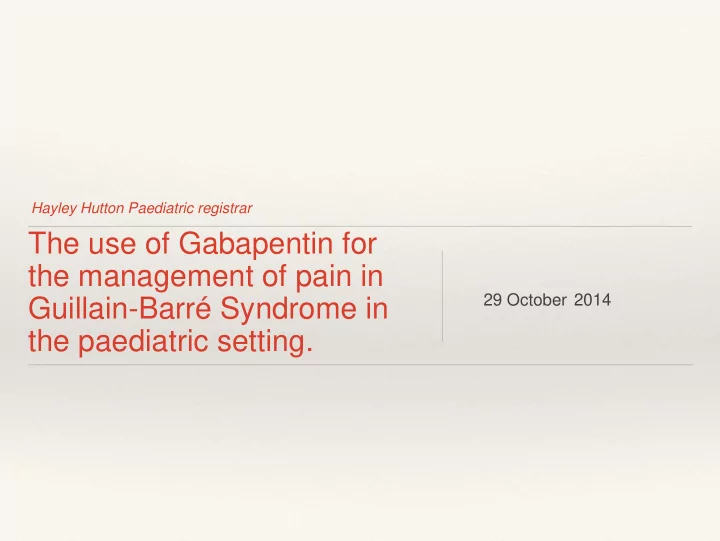

Hayley Hutton Paediatric registrar The use of Gabapentin for the management of pain in 29 October 2014 Guillain-Barré Syndrome in the paediatric setting.
Gabapentin The Good The Bad And the Unknown...
The unknown... Does OUR off label use of Gabapentin in Neuropathic pain stem from illicit marketing or is there some scientific evidence?
Efficacy of Gabapentin? Minimal paediatric data ❖ None out of Africa ❖ Pandey et al: Efficacy and safety of Gabapentin in ❖ adults with severe Guillain-Barré Syndrome Some proven efficacy in conditions such as: complex ❖ regional pain syndromes; peri operatively; post herpetic neuralgia.
Methodology Observational, retrospective study ❖ All patients admitted to RXH with Guillain- Barré ❖ syndrome 2002 - 2012 Medical records and Prescription charts reviewed ❖ Data was collected using Epidata and analysed using ❖ STATA v12.0
Incidence at RXH 16 12 No. 8 4 0 2002 2003 2004 2005 2006 2007 2008 2009 2010 2011 2012 Year
Age of population 25 20 15 No. 10 5 0 0 1 2 3 4 5 6 7 8 9 10 11 12 Age in years
Characteristics of Hospital stay Characteristic Overall Gaba Carba Neither P-value 14 days Length of hospital stay 48 45 10 0.85 (+-43) No. Needing PICU 41% 64 59 17 21 days Length of PICU stay 26 31 15 0.18 (+-33) No. Needing ventilatory support 31% 50 52 8 28% No. Needing a tracheostomy 45 52 1 Duration on tracheostomy 54 days 57 58 31 0.68
Characteristics of Pain Characteristic Overall Gaba Carba Neither P-value Proportion with documented 76% 100 86 54 0.67 pain 2.3 (+- 1.8) Mean no. Analgesics used 3.4 3.2 1.2 0.67 4 days (+-8) 12.7 Duration of pain 13.4 4.2 0.90 Episodes of breakthrough pain 55% 77 79 4 93% Caregiver at bedside 86 93 95
Limitations of the study ❖ Retrospective nature ❖ Lack of standardized methods to measure pain
Conclusions of the study ❖ Assessment of pain is suboptimal ❖ Dramatic increase in the use of Gabapentin at RXH
Looking ahead... ❖ Randomized, double blinded control trial ❖ Gabapentin vs Carbamazepine for the management of neuropathic pain ❖ Guillain-Barré Syndrome
A very big thank you to Prof Jo Wilmshurst and Prof JennyThomas
References: ❖ Walco GA, Dworkin RH, Krane EJ, LeBel AA, Treede RD. Neuropathic pain in children: special considerations . Mayo Clinic Proceedings [Internet]. 2010 [cited 2012 Sep 17]. page S33 – S41. Available from: http://171.67.112.83/content/85/3_suppl/S33.short ❖ Korinthenberg R, Mönting JS. Natural history and treatment effects in Guillain-Barré syndrome: a multicentre study . Arch Dis Child. 1996 Apr 1;74(4):281 – 7 ❖ Kar S, Menon L, Mondal M, Mukherjee S, Pal R, Sarbapalli D, et al. Spectrum of Guillain-Barre syndrome in tertiary care hospital at Kolkata . Journal of Natural Science, Biology and Medicine. 2011 Dec;2(2):211. ❖ Moulin DE, Hagen N, Feasby TE, Amireh R, Hahn A. Pain in Guillain-Barré syndrome . Neurology. 1997;48(2):328 – 31. ❖ Asbury AK, Cornblath DR. Assessment of current diagnostic criteria for Guillain-Barré syndrome. Annals of Neurology. 199;27(S1):21-24. ❖ Pandey CK, Raza M, Tripathi M, Navkar DV, Kumar A, Singh UK. The Comparative evaluation of Gabapentin and Carbamazepine for Pain Management in Guillain-Barré syndrome patients in the Intensive Care Unit. Anesthesia and Analgesia. 2005 Jul;101(1):220-5
Pregabalin? ❖ Very similar in action to Gabapentin ❖ Has been thought of as the superior pharmacological agent ❖ But... ❖ Safety and efficacy has not been established in children ❖ Not licensed for use in children <12 years ❖ Cost
Gabapentin fact file ❖ Derivative of GABA ❖ Absorbed via GIT with 80% bioavailability ❖ Distribution: not bound to plasma proteins, penetrates CSF ❖ Metabolism: Negligible ❖ Excretion: Renal excretion, t1/2 ❖ Adverse effects: dizziness and somnolence, dry mouth, oedema, blurred vision (dose dependent/reversible) ❖ MOA:*Inhibition of Ca channels
Pain rating tools ❖ Fraught with difficulty ❖ Few validated tools ❖ Neuropathic pain ❖ Self report requires an alert and communicative child ❖ Autonomic dysfunction ❖ FLACC; Self report; NCCPC-R
Recommend
More recommend